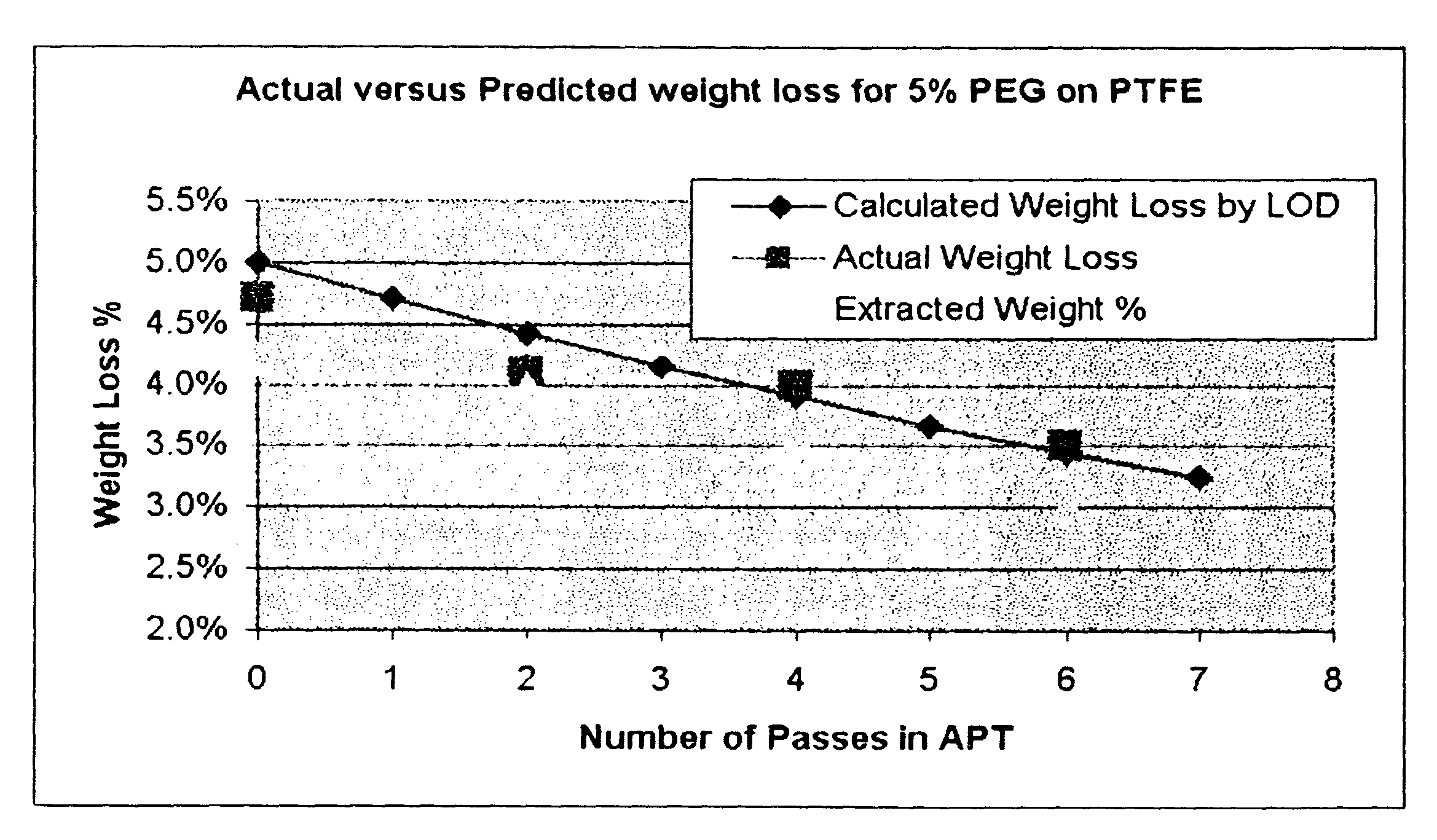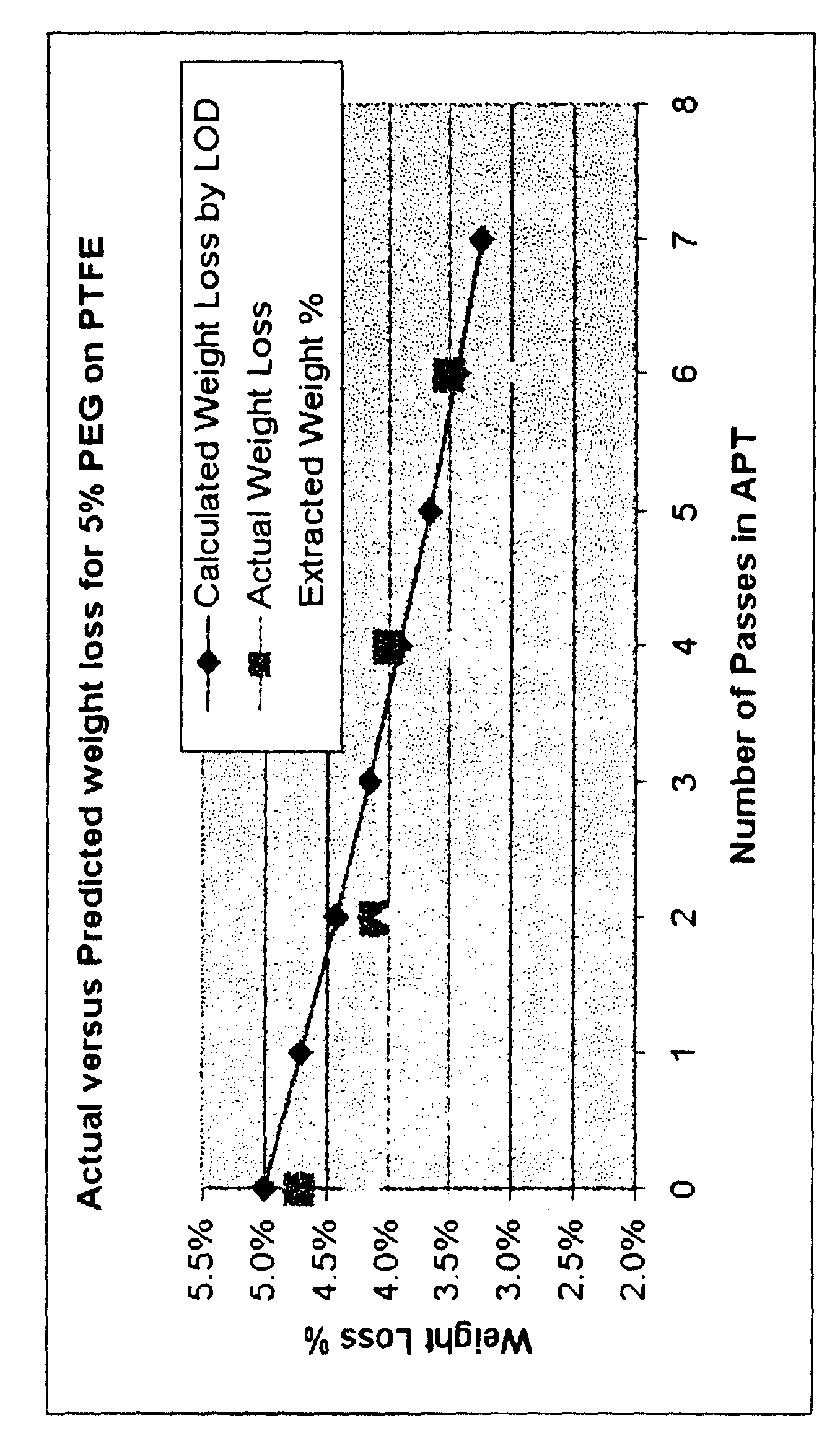Method of treating fluoropolymer particles and the products thereof
a technology of fluoropolymer particles and products, applied in the field of fluoropolymers, can solve the problems of poor electrical surface conductivity, adversely affecting the yield and the characteristics of film layers, and advances in the use of powdered fluoropolymers, and achieves the effects of reducing molecular weight, high energy, and efficient and cheap production
- Summary
- Abstract
- Description
- Claims
- Application Information
AI Technical Summary
Benefits of technology
Problems solved by technology
Method used
Image
Examples
example 1
Surface Treatment of Powders
[0066]In this Example, fluoropolymer powder particles were surface treated with a number of macromolecular chemical species.
[0067]Table 1 lists the fluoropolymer powders, their average particle size and molecular weight. Table 2 lists the macromolecular chemical species, their molecular weights, minimum and maximum concentrations, cross linking-agents and concentrations of the cross-linking agents.
[0068]
TABLE 1Average ParticleBase PowderSize. D50 MicronsMolecular Weight / Melt IndexPTFE35>1 × 106Irradiated PTFE3 to 151 × 103-1 × 106PVDF5Melt Viscosity 30 Kp @ 232° C.FEP5 to 25Melt Index 2 to 20 @ 375° C.ECTFE25Melt Index 12
[0069]
TABLE 2Typical conc.Min Conc.Max Conc.cross-linkingCommercialTypical Moleculargm / gmgm / gmCross-linkingagent gm / gm ofMacromolecularNameweightof powderof powderagentmacromoleculePEGCarbowax 900300, 900 and 14500.0030.1Polycup 1720.1PVOHCelvol 50215,0000.0010.05Polycup 1720.1PAASokalen PA 80S90,0000.0030.05Diak #30.05Epoxy FunctionalCoa...
example 2
Hydroxyl and Acid Numbers
[0072]Titrating both alcohol and acid functions of the surface treated fluoropolymer powder particles can be used to determine the degree of surface treatment.
[0073]In this Example the method of ASTM D 1957-86 was followed. This method utilizes acetylation reaction, which converts the primary alcohol to an ester through reaction with acetic anhydrate, liberating one mole of acetic acid. Upon hydrolysis, the same will require less potassium hydroxide to reach the phenolphthalein end point (neutralization) relative to a control, which upon hydrolysis yields 2 moles of acetic acid.
[0074]In this Example, 10.0 g of each individual surface treated powder was placed in a 250 ml Erlenmeyer flask and the total weight of the sample and flask were recorded. 5 ml of 3:1 volume mixture of pyridine: acetic anhydride was added to the flask.
[0075]9.0-11.0 g of the same sample was placed in a second flask for acid value titration and the total weight of the sample and flask ...
example 3
Weight Loss and Extraction Results
[0083]In this Example extraction tests were performed to determine the amount of surface treated material which is neither covalently attached nor permanently adsorbed one the fluoropolymer powder.
[0084]About 5 g of each sample was placed on an analytical balanced and the weight was recorded. 60 ml of an appropriate solvent (isopropanol for polyethylene glycol, deionized water for polyvinyl alcohol, etc.) was mixed with the sample. The mixture was mixed for 2 hours over low heat (about 100° F.). After heating, the sample mixture was poured into a 150 ml Durapore™ 0.22 μm filtration device. The material that was removed as the solvent passes through the filter and was collected. The total weight of the solvent (containing the extracted material) was recorded. About 1 g of the solvent was placed into an aluminum weighting dish and the total weight of the solvent and dish are weighed. The solvent was evaporated in a vented oven that was heated to 100° ...
PUM
| Property | Measurement | Unit |
|---|---|---|
| particle size | aaaaa | aaaaa |
| wt. % | aaaaa | aaaaa |
| temperatures | aaaaa | aaaaa |
Abstract
Description
Claims
Application Information
 Login to View More
Login to View More - R&D
- Intellectual Property
- Life Sciences
- Materials
- Tech Scout
- Unparalleled Data Quality
- Higher Quality Content
- 60% Fewer Hallucinations
Browse by: Latest US Patents, China's latest patents, Technical Efficacy Thesaurus, Application Domain, Technology Topic, Popular Technical Reports.
© 2025 PatSnap. All rights reserved.Legal|Privacy policy|Modern Slavery Act Transparency Statement|Sitemap|About US| Contact US: help@patsnap.com


